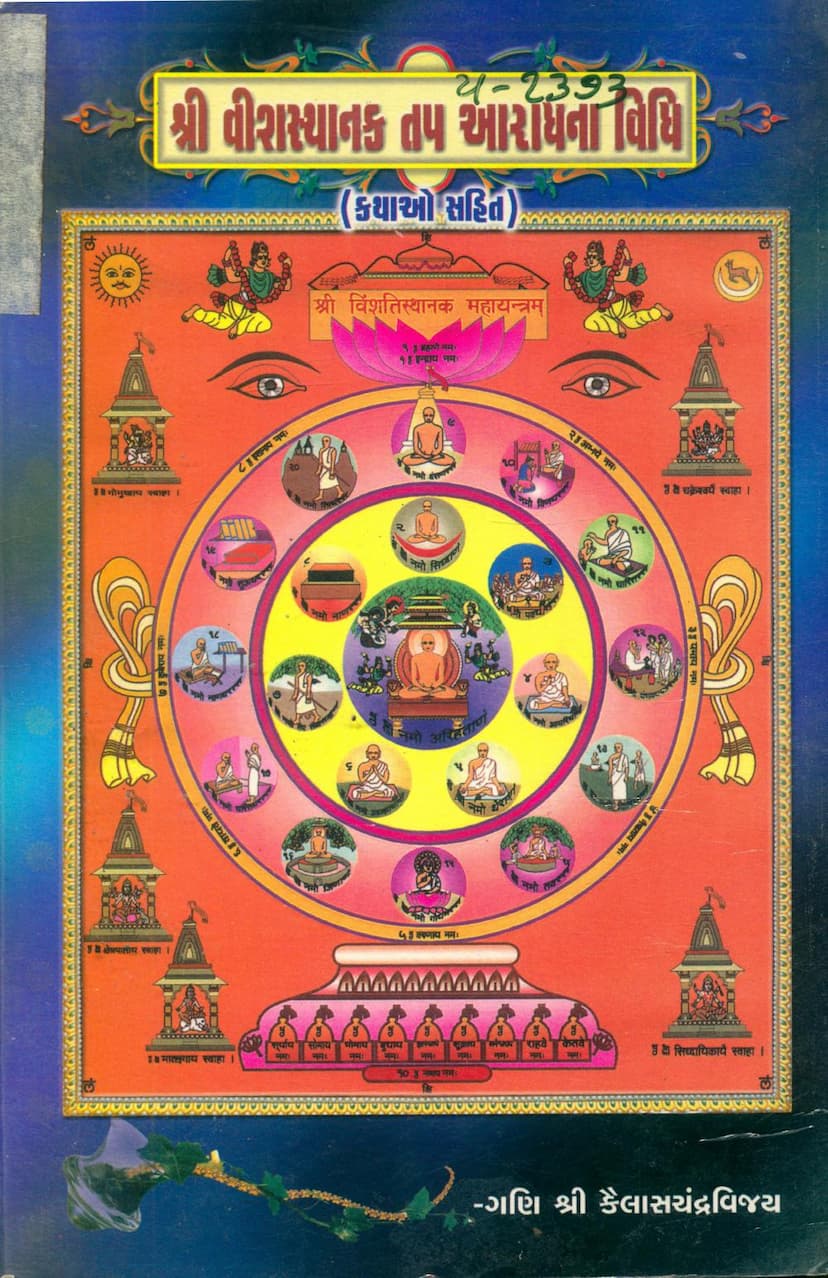Vishsthanak Tap Aradhana Vidhi
Added to library: September 2, 2025

Summary
Here's a comprehensive summary of the Jain text "Vishsthanak Tap Aradhana Vidhi" by Kailaschandravijay, based on the provided pages:
Book Title: Vishsthanak Tap Aradhana Vidhi (Procedure for the Worship of the Twenty-Station Fast) Author: Ganivar (a title of respect for a learned monk) Shri Kailaschandravijay M.S.A. Publisher: Guru Gunanuragi Bhaktavarg (Devotees Fond of the Qualities of the Guru)
Core Subject: The Vishsthanak Tap (Twenty-Station Fast)
This book is a detailed guide and compilation of rituals and stories related to the Vishsthanak Tap, a significant and meritorious fast in Jainism. The tap is described as a "best penance that leads to the attainment of the Tirthankar pada (status)."
Key Themes and Content:
-
Purpose of the Tap: The primary purpose of the Vishsthanak Tap is to "nikachit" (bind/accumulate) the Tirthankar Namakarma, which is the karmic bond that determines one's birth as a Tirthankar (a spiritual teacher who redeems beings). This is presented as the "one and only royal road" to becoming a Tirthankar, followed by all past, present, and future Tirthankaras.
-
The Twenty Stations (Padas): The tap involves the worship and meditation on twenty specific spiritual stations or qualities, which are: Arihant, Siddha, Pravachan, Acharya, Sthavira, Upadhyaya, Sadhu, Gnana (Knowledge), Darshana (Right Faith), Vinaya (Humility/Respect), Charitra (Conduct), Brahmacharya (Celibacy), Kriya (Action/Practice), Tap (Penance), Goutam (Dana/Charity), Jin (Jina's qualities), Samyama (Self-control), Abhinav Gnana (New knowledge), Shruta (Scriptural knowledge), and Tirtha (Spiritual community/institution). Each of these twenty 'padas' has detailed descriptions, associated virtues, and specific worship rituals (e.g., specific number of prostrations, recitation of mantras, meditation on colours).
-
Methods of Practice: The book outlines various ways to perform the tap, including:
- Performing the 'olis' (cycles of observance) for each station.
- The tap can be performed with different levels of austerity, from intense fasting ('athham' - fasting for three days continuously, or 'chhahth' - fasting for two days continuously) to less severe observances like 'ayambils' (eating one meal a day with specific restrictions) and 'ekasanas' (eating only once).
- The duration of the tap can vary, with an emphasis on completing 20 'olis' (cycles) over a period that can range from 1 year (for those performing intense fasting) to 10 years (for those performing less severe observances).
-
Importance of Bhavana (Inner Contemplation): The text strongly emphasizes that mere outward rituals of the tap are insufficient. "Bhavana" (proper contemplation and aspiration) is crucial for acquiring the Tirthankar Namakarma. The core aspiration is "Savajiva Karu Shasan Rasi" (May all beings become devoted to the Jain doctrine). This indicates a deep sense of universal compassion and a desire for the welfare of all souls.
-
Stories (Kathas): A significant portion of the book comprises inspiring stories of individuals (kings, queens, merchants, etc.) who performed the Vishsthanak Tap and attained the Tirthankar status or achieved great spiritual merit. These stories illustrate the power of the tap and the importance of righteous conduct, devotion, and pure intentions. Examples include stories of Devpal, Hastipal, Jinadatta, Purushottam Raja, Chandravarma, Harivahana, Kanakketu, and others.
-
Rituals and Prayers: The book provides detailed instructions for performing the rituals, including:
- Mantras and invocations to deities and specific stations.
- Chanting 'Navkaravali' (recitation of the Namokar Mantra).
- Performing 'Kayotsarga' (standing in meditation).
- The procedures for 'Deva Vandana' (worship of deities) and 'Chaitya Vandana' (worship of shrines).
- Specific instructions for 'Pachakhan' (vows and resolutions) for various types of fasts.
- Instructions for performing 'Poushadha' (a day of fasting and religious observance).
-
Authorship and Guidance: The book is attributed to Ganivar Shri Kailaschandravijay M.S.A., who is described as a 'tapasvi' (ascetic) and 'karmaprakriti bhag 1-2-3 ka bhavanuvad karta' (one who has translated the 'Karmaprakriti' into Gujarati). The book is dedicated to and inspired by the blessings of prominent Jain Acharyas (spiritual leaders), including P.P. Acharya Shri Vijay Nemisurishwarji M.S.A., P.P. Acharya Shri Vijay Vijnansurishwarji M.S.A., and P.P. Acharya Shri Vijay Kastursurishwarji M.S.A. The compilation is also attributed to the inspiration of P.P. Acharya Shri Vijay Chandrodayasurishwarji M.S.A. and P.P. Acharya Shri Vijay Ashokchandrasurishwarji M.S.A.
-
Publication and Support: The book has gone through multiple editions, indicating its popularity and usefulness. The publication has been supported by various philanthropic individuals and families, with special mention of the late Bhuriben Vrajlal Manekchand Shah family as the "Adharshila" (foundation stone) for the third edition.
-
Spiritual Teachings: Interspersed throughout the text are simple yet profound spiritual maxims or "soneri suvakyo" (golden sayings) for the reader, such as "Live with equanimity," "Be humble," "Understand your true self," "Do not harbor hatred," "Find joy even in suffering," "Show compassion," and "Do not be negligent."
In essence, "Vishsthanak Tap Aradhana Vidhi" is a comprehensive manual for the rigorous and spiritually rewarding Vishsthanak Tap, providing not only the procedural details but also the underlying philosophy, historical context through inspiring stories, and the ultimate goal of spiritual upliftment and liberation.